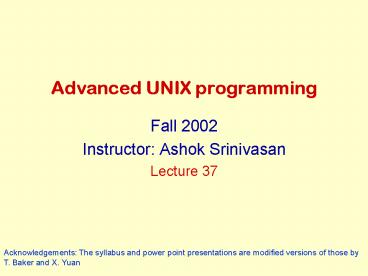Advanced UNIX programming PowerPoint PPT Presentation
Title: Advanced UNIX programming
1
Advanced UNIX programming
- Fall 2002
- Instructor Ashok Srinivasan
- Lecture 37
Acknowledgements The syllabus and power point
presentations are modified versions of those by
T. Baker and X. Yuan
2
Announcements
- Project
- Presentations next week
- Demo next week
- Quiz Monday
- Mondays and todays lecture material
- Mondays lecture material included in finals
3
Week 14 Topics
- Signals and threads
- Terminal I/O
- APUE chapter 11
- Signal driven I/O
- UNP chapter 22
- Non-blocking I/O
- UNP chapter 15
4
Terminal I/O
- Canonical mode (not our focus)
- The default mode, input line by line
- Non-canonical mode
- Input characters are not assembled
- termios structure
- tcgetattr and tcsetattr
- Turning on the non-canonical mode
5
termios structure
- struct termios
- Stores all the characteristics of a terminal
device that we can examine and change - termios.h
- struct termios
- tcflag_t c_iflag / input flag /
- tcflag_t c_oflag / output flag /
- tcflag_t c_cflag / control flags /
- tcflag_t c_lflag / local flags /
- cc_t c_ccNCCS / control characters
/
6
Functions to get and set the fields in the
termios structure
- include lttermios.hgt
- int tcgetattr(int fildes, struct termios
termios_p) - int tcsetattr(int fildes, int optional_actions,
const struct termios termios_p) - optional_actions
- TCSANOW
- TCSADRAIN
- TCSAFLUSH
7
Turn on the noncanonical mode
- Unset the ICANON flag in c_lflag
- myterm.c_lflag ICANON
- When will a read return using the noncanonical
mode for input? - Number of characters (VMIN)
- Time (VTIME)
- Specified in the c_cc field
- c_ccVMIN ???, c_ccVTIME ???
- VMIN gt 0, VTIME gt 0
- VMIN 0, VTIME gt 0
- VMIN gt 0, VTIME 0
- VMIN 0, VTIME 0
- See example1.c and example2.c
8
Signal driven I/O
- The kernel raises a signal when something happens
to a file descriptor - Signal driven I/O for sockets
- Establish a signal handler for SIGIO
- Set the socket owner
- Enable signal-driven I/O for the socket
9
When is SIGIO raised?
- For UDP sockets
- A datagram arrives
- An error occurs
- For TCP sockets
- A connection request has completed
- A disconnect request has been initiated
- A disconnect request has completed
- Half of a connection has been shut down
- Data has arrived
- Data has been sent
- Too many SIGIOs for a TCP socket rarely used
10
Non-blocking I/O
- For input operations
- read, recv, recvfrom, etc.
- If the operation cannot be satisfied, return with
an error of EWOULDBLOCK - For output operations
- write send, sendto, etc.
- If no buffer space, return with an error of
WOULDBLOCK - For accept
- If a new connection is not available, return
with an error of EWOULDBLOCK - For connect
- If the connection cannot be established right
away, EINPROGRESS is returned

